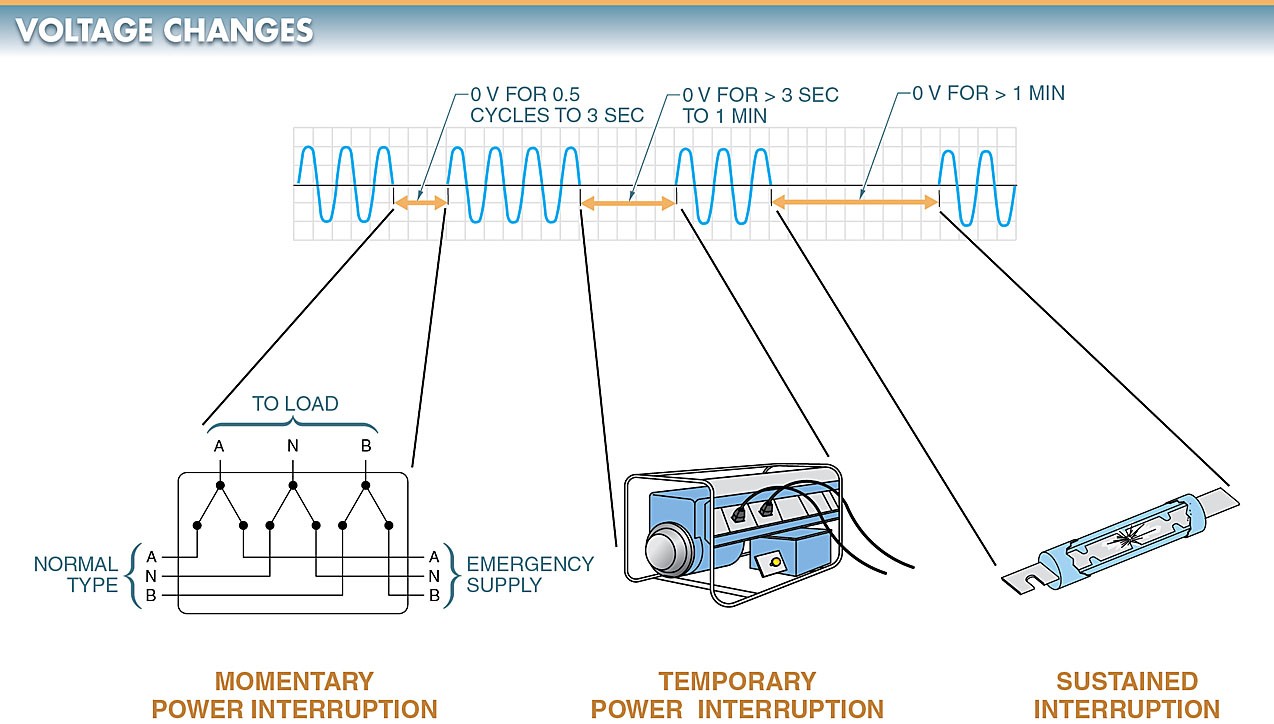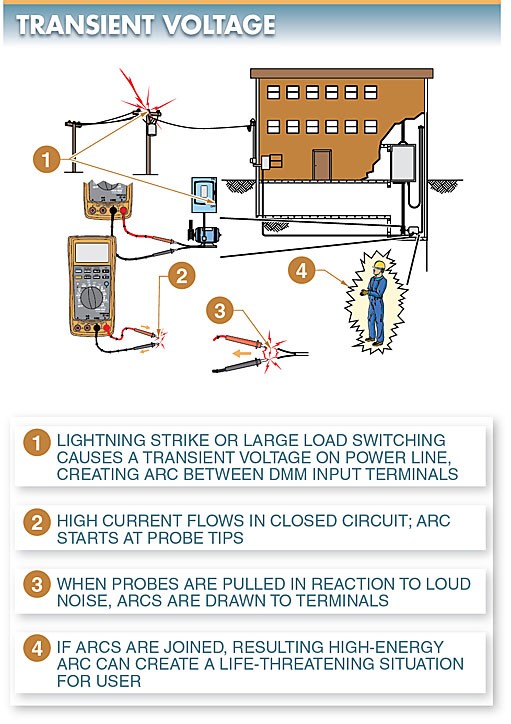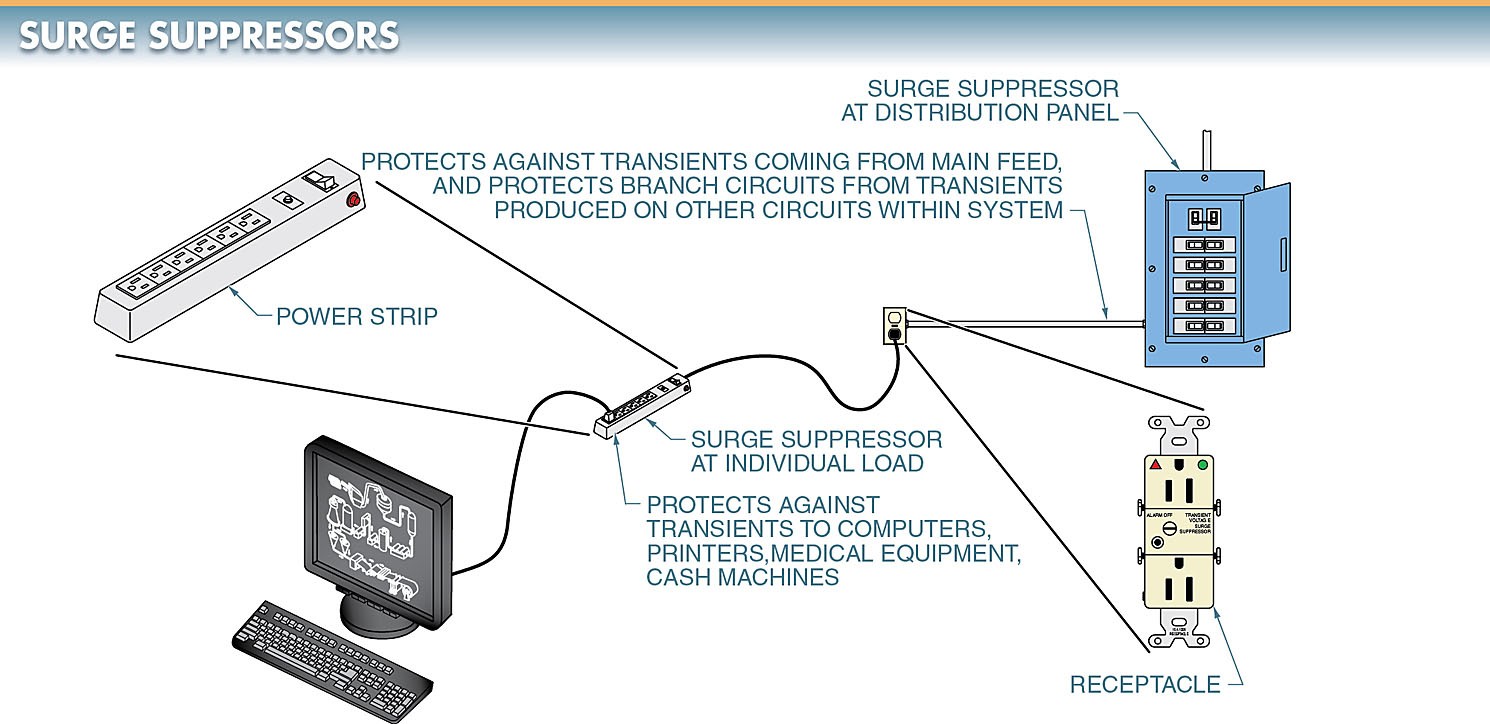AC generators are designed to produce a rated output voltage. In addition, all electrical and electronic equipment is rated for operation at a specific voltage. The rated voltage is a voltage range that was normally ±10%. Today, however, with many components de-rated to save energy and operating cost, the range is normally +5% to −10%.
A voltage range is used because an overvoltage is generally more damaging than an under-voltage. Equipment manufacturers, utility companies, and regulating agencies must routinely compensate for changes in system voltage.
Backup generators are used to compensate for voltage changes. A backup generator can be powered by a diesel, gasoline, natural gas, or propane engine connected to the generator.
If there is any power interruption in the time period between the loss of main utility power and when the generator starts providing power, the generator is usually classified as a standby (emergency) power supply.
Voltage changes in an electrical power system may be categorized as momentary, temporary, or sustained. See Figure 1.
Figure 1. Voltage changes in an electrical power system may be categorized as momentary, temporary, or sustained.
Momentary Power Interruptions
A momentary power interruption is a decrease to 0 V on one or more power lines lasting from 0.5 cycles up to 3 sec. All power distribution systems have momentary power interruptions during normal operation.
Momentary power interruptions can be caused when lightning strikes nearby, by utility grid switching during a problem (such as a short on one line), or during the open circuit, transition switching. Open circuit transition switching is a process in which power is momentarily disconnected when switching a circuit from one voltage supply (or level) to another.
Tech Fact
Electrical equipment and surge suppressors may be described by the terms “ride-through capability” and “let-through capability.”
The term “ride-through capability” is used by manufacturers to describe the ability of electrical equipment to withstand a momentary power interruption.
The term “let-through capability” is used to describe how much voltage a surge suppressor will allow through the equipment it protects.
Temporary Power Interruptions
A temporary power interruption is a decrease to 0 V on one or more power lines lasting for more than 3 sec up to 1 min. Automatic circuit breakers and other circuit protection equipment protect all power distribution systems.
Circuit protection equipment is designed to remove faults and restore power. An automatic circuit breaker normally takes from 20 cycles to about 5 sec to close.
If the power is restored, the power interruption is only temporary. If power is not restored, a temporary power interruption becomes a sustained power interruption.
A temporary power interruption can also be caused by a time gap between power interruptions and when a backup power supply (generator) takes over or if someone accidentally opens the circuit by switching the wrong circuit breaker switch.
Sustained Power Interruptions
A sustained power interruption is a decrease to 0 V on all power lines for a period of more than 1 min. All power distribution systems have a complete loss of power at some time.
Sustained power interruptions (outages) are commonly the result of storms, tripped circuit breakers, blown fuses, and/or damaged equipment.
The effect of a power interruption on a load depends on the load and the application. If a power interruption could cause equipment, production, and/or security problems that are not acceptable, an uninterruptible power system can be used.
An uninterruptible power system (UPS) is a power supply that provides constant on-line power when the primary power supply is interrupted. For long-term power interruption protection, a generator/UPS is used. For short-term power interruptions, a static UPS is used.
Transient Voltages in Electrical Power System
A transient voltage also referred to as a voltage spike, is a temporary, unwanted voltage in an electrical circuit.
Transient voltages typically exist for a very short time but are often larger in magnitude than voltage surges and very erratic. Transient voltages occur due to lightning strikes, unfiltered electrical equipment, and power is switched on and off. High transient voltages may reach several thousand volts. A transient voltage on a 120 V power line can reach 1000 V (1 kV) or more.
High transient voltages exist close to a lightning strike or when large (high-current) loads are switched off. For example, when a large motor (100 HP) is turned off, a transient voltage can move down the power distribution system.
If a Digital Multimeter is connected to a point along the system in which the high transient voltage is present, an arc can be created inside the DMM. Once started, the arc can cause a high-current short in the power distribution system even after the original high transient voltage is gone.
The high-current short can turn into an arc blast. An arc blast is an explosion that occurs when the surrounding air becomes ionized and conductive. See Figure 2.
Figure 2. When taking measurements in an electrical circuit, transient voltages can cause electrical shock and/or damage to equipment.
The amount of current drawn and potential damage caused depends on the specific location of the power distribution system. All power distribution systems have current limits set by fuses and circuit breakers along the system.
The current rating (size) of fuses and circuit breakers decreases as the distance from the main distribution panel increases. The farther away from the main distribution panel, the less likely the high transient voltage is to cause damage.
Transient voltages are normally erratic, large voltages or surges that have a short duration and a short rise time. Computers, electronic circuits, and specialized electrical equipment require protection against transient voltages.
Protection methods commonly include proper wiring, grounding, shielding of the power lines, and use of surge suppressors. A surge suppressor is an electrical device that provides protection from transient voltages by limiting the level of voltage allowed downstream from the surge suppressor. Surge suppressors can be installed at service entrance panels and at individual loads. See Figure 3.
Figure 3. A surge suppressor is an electrical device that provides protection from high-level transients by limiting the level of voltage allowed downstream from the surge suppressor.



